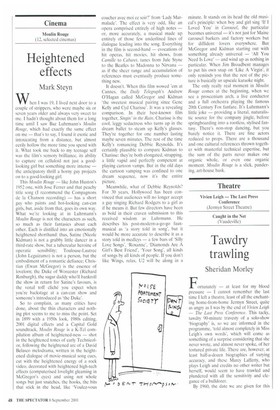Heightened effects
Mark Steyn
When I was 19, I lived next door to a couple of strippers, who were maybe six or seven years older and always very sweet to me. I hadn't thought about them for a long time until I saw Baz Luhrmann's Moulin Rouge, which had exactly the same effect on me — that's to say, I found it exotic and intoxicating from a distance, but almost eerily hollow the more time you spend with it. What took me back to my teenage self was the film's sensory brilliance, its ability to capture on celluloid not just a goodlooking girl but something more intense — the anticipatory thrill a horny guy projects on to a good-looking girl.
This Moulin Rouge — like John Huston's 1952 one, with Jose Ferrer and that peachy title song (I recommend the Compagnons de la Chanson recording) — has a short guy who paints and hot-looking can-can girls, but, aside from that, goes its own way. What we're looking at in Luhrmann's Moulin Rouge is not the characters as such, so much as their fantasies about each other. Each is distilled into an emotionally heightened shorthand: thus, Saline (Nicole Kidman) is not a grubby little dancer in a third-rate show, but a tubercular heroine of operatic sensibility; Toulouse-Lautrec (John Leguizamo) is not a person, but the embodiment of a romantic defiance; Christian (Ewan McGregor) is the essence of lovelorn; the Duke of Worcester (Richard Roxburgh), the sugar daddy who'll bankroll the show in return for Satine's favours, is the venal toff cliché you expect when you're backstage at a can-can show and someone's introduced as 'the Duke'.
So to complain, as many critics have done, about the thin characters and nothing plot seems to me to miss the point. Set in 1899 with a 1950s look. 1980s editing. 2001 digital effects and a Capital Gold soundtrack. Moulin Rouge is a K-Tel compilation album of heightened-ness — shot in the heightened tones of early Technicolor, following the heightened arc of a David Belasco melodrama, written in the heightened dialogue of movie-musical song cues, Cut with the heightened energy of a rock video, decorated with heightened high-tech effects (computerised lovelight gleaming in McGregor's eyes) and using not whole songs but just snatches, the hooks, the bits that stick in the head, like -Voulez-vous
coucher avec moi cc soir'?' from 'Lady Marmalade'. The effect is very odd, like an opera comprised entirely of high notes — or, more accurately, a musical made up entirely of those few underlined lines of dialogue leading into the song. Everything in the film is second-hand — evocations of hit operas, hit movies, hit shows, from Camille to Cabaret, tunes from Jule Styne to the Beatles to Madonna to Nirvana — as if the sheer range and accumulation of references must eventually produce something new.
It doesn't. When this film wowed 'ern at Cannes, the Daily Telegraph's Andrew O'Hagan called McGregor and Kidman 'the sweetest musical pairing since Gene Kelly and Cyd Charisse'. It was a revealing comparison. In their best-known film together, Singin' in the Rain, Charisse is the cool, leggy seductress who turns up in the dream ballet to steam up Kelly's glasses. They're together for one number lasting maybe seven minutes. The rest of the time Kelly's romancing Debbie Reynolds. It's certainly plausible to compare Kidman to Charisse: they're both elongated, strapping, a little vapid and perfectly competent at playing cartoon vamps. But in the old days the cartoon vamping was confined to one dream sequence, now it's the entire picture.
Meanwhile, what of Debbie Reynolds? For 30 years, Hollywood has been convinced that audiences will no longer accept a guy singing Richard Rodgers to a girl as if he means it. But few directors have been as bold in their craven submission to this received wisdom as Luhrmann. He describes his post-modern-a-go-go fauxmusical as 'a story told in song', but it would be more accurate to describe it as a story told in medleys — a few bars of 'Silly Love Songs', 'Roxanne', 'Diamonds Are A Girl's Best Friend', 'Your Song', all kinds of songs by all kinds of people. If you don't like Wings, relax, U2 will be along in a minute. It stands on its head the old musical's principle: when boy and girl sing 'If I Loved You' in Carousel, the particular becomes universal — it's not just for Maine carousel barkers and factory workers but for diffident lovers everywhere. But McGregor and Kidman starting out with something already universal — 'All You Need Is Love' and wind up as nothing in particular. When Jim Broadbent manages to put his own snap on 'Like A Virgin', it only reminds you that the rest of the picture is basically an upscale karaoke night.
The only really real moment in Moulin Rouge comes at the beginning, when we see a proscenium arch, a live conductor and a full orchestra playing the famous 20th Century Fox fanfare. It's Luhrmann's little joke — providing a literal, naturalistic source for the company jingle, before springboarding into a rootless, stylised fantasy. There's non-stop dancing, but you barely notice it. There are fine actors reduced to props. There are a thousand and one cultural references thrown together with masterful technical expertise, but the sum of the parts never makes one organic whole, or even one organic moment. Moulin Rouge is a slick, pandering, art-house husk.


































































 Previous page
Previous page